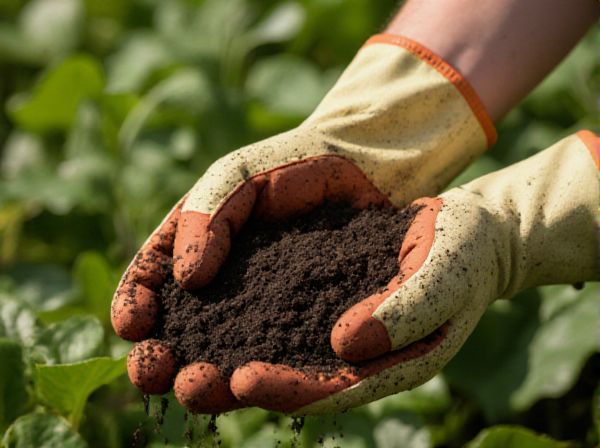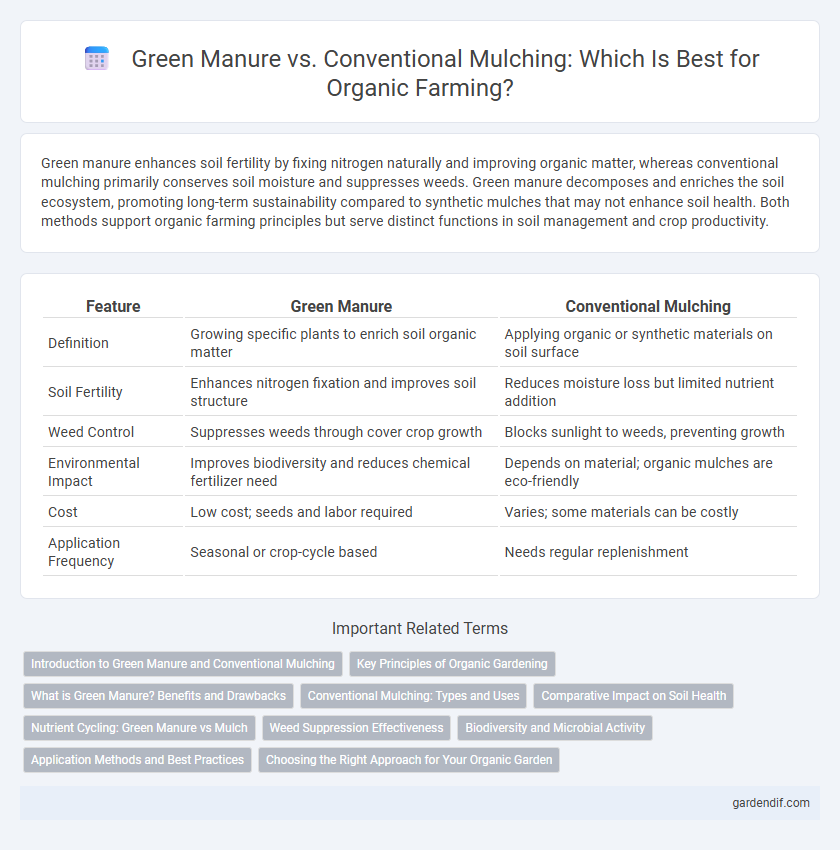
Green manure vs conventional mulching Illustration
Green manure enhances soil fertility by fixing nitrogen naturally and improving organic matter, whereas conventional mulching primarily conserves soil moisture and suppresses weeds. Green manure decomposes and enriches the soil ecosystem, promoting long-term sustainability compared to synthetic mulches that may not enhance soil health. Both methods support organic farming principles but serve distinct functions in soil management and crop productivity.
Table of Comparison
| Feature | Green Manure | Conventional Mulching |
|---|---|---|
| Definition | Growing specific plants to enrich soil organic matter | Applying organic or synthetic materials on soil surface |
| Soil Fertility | Enhances nitrogen fixation and improves soil structure | Reduces moisture loss but limited nutrient addition |
| Weed Control | Suppresses weeds through cover crop growth | Blocks sunlight to weeds, preventing growth |
| Environmental Impact | Improves biodiversity and reduces chemical fertilizer need | Depends on material; organic mulches are eco-friendly |
| Cost | Low cost; seeds and labor required | Varies; some materials can be costly |
| Application Frequency | Seasonal or crop-cycle based | Needs regular replenishment |
Introduction to Green Manure and Conventional Mulching
Green manure involves growing specific cover crops like clover or legumes that are plowed back into the soil to enhance nutrient content and organic matter, promoting soil fertility and structure. Conventional mulching typically uses materials such as straw, wood chips, or plastic films to suppress weeds, retain moisture, and regulate soil temperature without directly enriching the soil's nutrient profile. Both methods offer sustainable soil management benefits, but green manure actively improves soil health through biological nitrogen fixation, whereas conventional mulching focuses primarily on physical protection and moisture conservation.
Key Principles of Organic Gardening
Green manure enhances soil fertility naturally by incorporating cover crops that fix nitrogen and improve organic matter, aligning with organic gardening principles of sustainability and soil health. Conventional mulching mainly conserves moisture and suppresses weeds but may lack the nutrient cycling benefits provided by green manure. Emphasizing soil ecosystem balance, organic practices prioritize green manure to foster nutrient-rich, biologically active soil without synthetic inputs.
What is Green Manure? Benefits and Drawbacks
Green manure refers to the practice of growing specific plants, such as legumes or cover crops, which are later incorporated into the soil to improve its fertility and structure. This organic technique enhances soil nitrogen content, promotes microbial activity, and reduces erosion, contrasting with conventional mulching that primarily provides weed suppression and moisture retention. While green manure enriches soil health and supports sustainable farming, it requires additional time and labor for crop cultivation and incorporation, which can be seen as drawbacks compared to the more immediate effects of conventional mulching.
Conventional Mulching: Types and Uses
Conventional mulching involves using materials like straw, wood chips, plastic sheets, and shredded leaves to cover soil surfaces, enhancing moisture retention, temperature regulation, and weed suppression. Organic mulches such as straw and wood chips slowly decompose, enriching soil fertility, while inorganic options like plastic mulch provide effective weed control and soil warming without nutrient contribution. These diverse mulching types support various agricultural and gardening practices by maintaining soil health, improving crop yields, and reducing water usage.
Comparative Impact on Soil Health
Green manure significantly enhances soil health by increasing organic matter, improving soil structure, and boosting microbial activity, whereas conventional mulching primarily conserves moisture and suppresses weeds without substantially enriching soil nutrients. The nitrogen fixation capability of leguminous green manures directly replenishes soil fertility, promoting sustainable crop growth compared to non-decomposable conventional mulch materials. Long-term use of green manure leads to improved soil biodiversity and reduced erosion risk, surpassing the soil conditioning benefits offered by conventional mulching practices.
Nutrient Cycling: Green Manure vs Mulch
Green manure enhances nutrient cycling by fixing atmospheric nitrogen and improving soil organic matter, leading to sustained nutrient availability. Conventional mulching primarily conserves soil moisture and suppresses weeds but offers limited nutrient input compared to green manure. Integrating green manure boosts microbial activity, accelerating nutrient mineralization and promoting healthier plant growth in organic systems.
Weed Suppression Effectiveness
Green manure significantly enhances weed suppression by enriching soil with organic matter and fostering beneficial microbial activity, which inhibits weed seed germination and growth. Conventional mulching provides a physical barrier that limits light penetration, reducing weed emergence but may break down faster and require frequent replenishment. Combining green manure with conventional mulching often results in superior weed control by integrating biological soil health improvements with immediate surface coverage.
Biodiversity and Microbial Activity
Green manure enhances biodiversity by introducing diverse plant species that support various insects and soil organisms, while conventional mulching primarily provides a physical barrier with limited biological input. Soil microbial activity is significantly higher under green manure treatments due to the organic matter and root exudates that stimulate microbial populations, compared to the more static environment created by conventional mulch. This increased microbial diversity under green manure promotes nutrient cycling and soil health, essential for sustainable organic farming systems.
Application Methods and Best Practices
Green manure involves growing specific cover crops like clover or legumes that are tilled back into the soil to enhance nutrient content and improve soil structure, while conventional mulching typically uses organic or synthetic materials spread over the soil surface to retain moisture and suppress weeds. Application methods for green manure require timed planting and incorporation before flowering to maximize nutrient release, whereas conventional mulching demands even layer spreading and periodic replenishment to maintain its benefits. Best practices emphasize selecting appropriate cover crop species for local soil conditions in green manure and using biodegradable, pest-free mulches in conventional mulching to promote sustainable soil health in organic farming.
Choosing the Right Approach for Your Organic Garden
Green manure enhances soil fertility by fixing nitrogen and increasing organic matter, making it ideal for organic gardens seeking sustainable nutrient cycling. Conventional mulching primarily conserves moisture, suppresses weeds, and moderates soil temperature, but it offers limited nutrient input compared to green manure. Selecting the appropriate method depends on your garden's specific needs for nutrient enrichment versus soil protection to optimize organic growth.
Green manure vs conventional mulching Infographic

 gardendif.com
gardendif.com